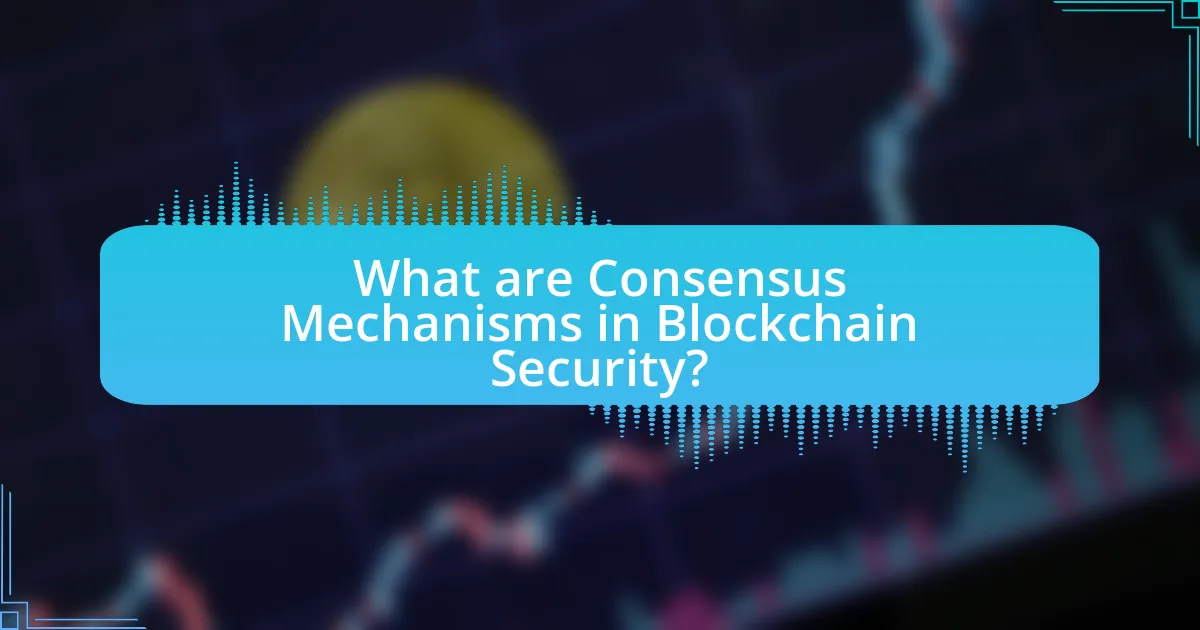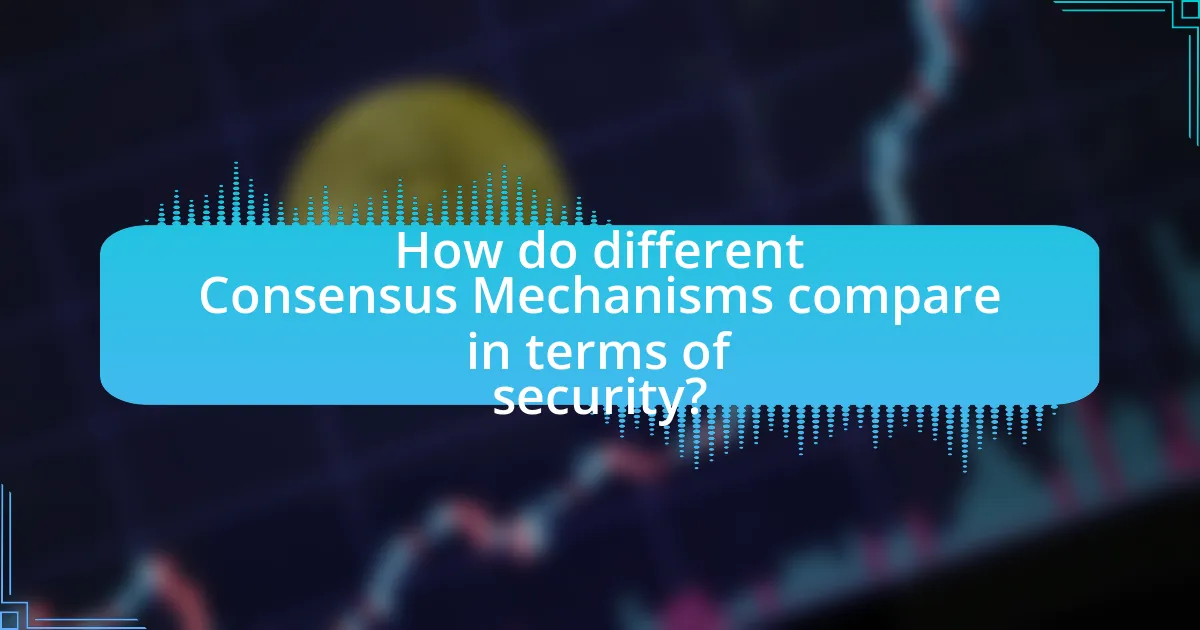Consensus mechanisms are critical protocols in blockchain security that ensure agreement among participants on the validity of transactions, thereby maintaining the integrity of the blockchain. This article analyzes various consensus mechanisms, including Proof of Work and Proof of Stake, highlighting their roles in preventing double-spending and securing networks against malicious activities. It discusses the effectiveness of these mechanisms in terms of security, scalability, and decentralization, while also examining challenges they face and the implications of security breaches. Additionally, the article explores real-world applications, case studies, and future trends that could influence the evolution of consensus mechanisms in blockchain technology.

What are Consensus Mechanisms in Blockchain Security?
Consensus mechanisms in blockchain security are protocols that ensure all participants in a blockchain network agree on the validity of transactions. These mechanisms, such as Proof of Work and Proof of Stake, play a critical role in maintaining the integrity and security of the blockchain by preventing double-spending and ensuring that all nodes have a consistent view of the ledger. For instance, Proof of Work requires miners to solve complex mathematical problems, which secures the network by making it computationally expensive to alter any part of the blockchain. This process has been validated by the success of Bitcoin, which has maintained its security and integrity since its inception in 2009.
How do Consensus Mechanisms contribute to Blockchain Security?
Consensus mechanisms enhance blockchain security by ensuring that all participants in the network agree on the validity of transactions before they are added to the blockchain. This agreement process prevents malicious actors from altering transaction data, as they would need to control a majority of the network’s computational power or stake, depending on the mechanism used. For instance, in Proof of Work, the requirement for significant computational resources makes it economically unfeasible for an attacker to manipulate the blockchain. Similarly, in Proof of Stake, the need to own a substantial amount of the cryptocurrency deters fraudulent activities. Historical data shows that blockchains employing robust consensus mechanisms, such as Bitcoin and Ethereum, have maintained high levels of security and integrity, with minimal successful attacks reported.
What are the key functions of Consensus Mechanisms in securing blockchain networks?
Consensus mechanisms are essential for securing blockchain networks by ensuring agreement among distributed nodes on the validity of transactions. They achieve this through processes like proof of work or proof of stake, which prevent double-spending and maintain the integrity of the blockchain. For instance, in Bitcoin’s proof of work, miners compete to solve complex mathematical problems, which secures the network by making it computationally expensive to alter transaction history. This mechanism also incentivizes honest behavior, as participants are rewarded for validating transactions correctly. Additionally, consensus mechanisms enhance network resilience against attacks, such as Sybil attacks, by requiring significant resources to compromise the network’s integrity.
How do Consensus Mechanisms prevent malicious activities in blockchain?
Consensus mechanisms prevent malicious activities in blockchain by ensuring that all participants agree on the validity of transactions before they are added to the blockchain. This agreement is achieved through various methods, such as Proof of Work or Proof of Stake, which require participants to demonstrate their commitment to the network, either by solving complex mathematical problems or by holding a stake in the cryptocurrency.
For instance, in Proof of Work, miners compete to solve cryptographic puzzles, and the first to solve it gets to add the block, making it costly and time-consuming for any malicious actor to alter past transactions. Similarly, in Proof of Stake, validators are chosen based on the number of coins they hold and are willing to “stake,” which aligns their financial interests with the network’s integrity.
These mechanisms create a significant barrier to entry for malicious activities, as altering any part of the blockchain would require an attacker to control a majority of the network’s computational power or stake, which is economically unfeasible in a well-distributed network. Thus, consensus mechanisms effectively secure the blockchain against fraud and manipulation.
What types of Consensus Mechanisms exist?
There are several types of consensus mechanisms used in blockchain technology, including Proof of Work (PoW), Proof of Stake (PoS), Delegated Proof of Stake (DPoS), Practical Byzantine Fault Tolerance (PBFT), and Proof of Authority (PoA). Proof of Work, utilized by Bitcoin, requires miners to solve complex mathematical problems to validate transactions, ensuring security through computational effort. Proof of Stake allows validators to create new blocks based on the number of coins they hold and are willing to “stake” as collateral, promoting energy efficiency. Delegated Proof of Stake involves stakeholders voting for a small number of delegates to validate transactions, enhancing scalability. Practical Byzantine Fault Tolerance is designed for permissioned networks, allowing consensus even if some nodes fail or act maliciously. Proof of Authority relies on a limited number of trusted nodes to validate transactions, prioritizing speed and efficiency. Each mechanism has distinct characteristics that influence blockchain security and performance.
What are the differences between Proof of Work and Proof of Stake?
Proof of Work (PoW) and Proof of Stake (PoS) are two distinct consensus mechanisms used in blockchain technology. PoW requires participants, known as miners, to solve complex mathematical problems to validate transactions and create new blocks, consuming significant computational power and energy; for instance, Bitcoin, which uses PoW, has been reported to consume around 100 terawatt-hours annually. In contrast, PoS allows validators to create new blocks based on the number of coins they hold and are willing to “stake” as collateral, resulting in lower energy consumption; Ethereum transitioned to PoS in 2022, significantly reducing its energy usage by approximately 99.95%. Thus, the primary differences lie in their energy efficiency, the method of transaction validation, and the incentives for participants.
How do Delegated Proof of Stake and Practical Byzantine Fault Tolerance work?
Delegated Proof of Stake (DPoS) works by allowing stakeholders to elect a small number of delegates who validate transactions and maintain the blockchain. In this system, token holders vote for delegates based on their reputation and performance, which creates a more efficient consensus process compared to traditional Proof of Stake systems. DPoS enhances scalability and reduces the time required for transaction confirmations, as a limited number of delegates are responsible for block production.
Practical Byzantine Fault Tolerance (PBFT) operates by enabling a network of nodes to reach consensus even in the presence of faulty or malicious nodes. In PBFT, nodes communicate with each other to agree on the state of the system, requiring a supermajority (typically two-thirds) of nodes to validate a transaction. This mechanism ensures that as long as less than one-third of the nodes are faulty, the system can achieve consensus and maintain integrity.
Both DPoS and PBFT improve blockchain security by addressing different challenges: DPoS focuses on efficient transaction processing through delegated authority, while PBFT emphasizes resilience against faults and attacks through consensus among multiple nodes.
Why is the effectiveness of Consensus Mechanisms important?
The effectiveness of consensus mechanisms is crucial because it directly impacts the security, scalability, and decentralization of blockchain networks. Effective consensus mechanisms ensure that all participants in the network agree on the state of the blockchain, preventing issues such as double-spending and maintaining data integrity. For instance, Bitcoin’s Proof of Work mechanism has been proven to secure the network against attacks, as it requires significant computational resources to alter transaction history, making it economically unfeasible for malicious actors. Additionally, the effectiveness of consensus mechanisms influences transaction speed and energy consumption, which are vital for the adoption of blockchain technology in various applications.
How does the effectiveness of Consensus Mechanisms impact network performance?
The effectiveness of consensus mechanisms directly impacts network performance by influencing transaction speed, scalability, and security. For instance, Proof of Work, used by Bitcoin, ensures high security but results in slower transaction times and higher energy consumption, limiting scalability. In contrast, Proof of Stake, utilized by Ethereum 2.0, enhances transaction speed and reduces energy usage, thereby improving overall network performance. Studies show that networks employing efficient consensus mechanisms can process thousands of transactions per second, significantly outperforming those with less effective methods. This correlation between consensus mechanism effectiveness and network performance is critical for the scalability and usability of blockchain technologies.
What role does user trust play in the effectiveness of Consensus Mechanisms?
User trust is crucial for the effectiveness of consensus mechanisms, as it directly influences user participation and network security. When users trust the consensus mechanism, they are more likely to engage with the network, validate transactions, and contribute to its overall integrity. For instance, studies have shown that in blockchain networks like Bitcoin, user trust in the decentralized consensus process enhances the willingness to invest and transact, thereby increasing network robustness. Additionally, a lack of trust can lead to reduced participation, making the network vulnerable to attacks, as evidenced by incidents where distrust led to forks or abandonment of projects. Thus, user trust is a foundational element that underpins the operational success and security of consensus mechanisms in blockchain systems.
How do Consensus Mechanisms evolve to enhance security?
Consensus mechanisms evolve to enhance security by incorporating advanced cryptographic techniques, improving decentralization, and adapting to emerging threats. For instance, Proof of Stake (PoS) mechanisms reduce the risk of centralization by allowing validators to be selected based on their stake, which incentivizes honest behavior and increases network security. Additionally, hybrid models that combine elements of Proof of Work (PoW) and PoS have emerged, providing a balance between energy efficiency and security. Historical data shows that networks like Ethereum are transitioning from PoW to PoS to mitigate vulnerabilities associated with mining centralization and to enhance overall security. These evolutionary changes are driven by the need to address scalability issues and to protect against attacks such as Sybil attacks and double-spending, thereby reinforcing the integrity of blockchain systems.
What challenges do Consensus Mechanisms face in maintaining security?
Consensus mechanisms face several challenges in maintaining security, primarily including susceptibility to attacks, scalability issues, and the risk of centralization. For instance, proof-of-work mechanisms are vulnerable to 51% attacks, where a single entity gains control over the majority of the network’s mining power, allowing them to manipulate transactions. Additionally, as the number of transactions increases, many consensus mechanisms struggle to maintain speed and efficiency, leading to potential security vulnerabilities during high-load periods. Furthermore, some mechanisms, like proof-of-stake, can lead to centralization, where wealth concentration among a few stakeholders undermines the decentralized nature of blockchain, making it easier for collusion and manipulation to occur. These challenges highlight the ongoing need for innovation and improvement in consensus mechanisms to enhance security in blockchain systems.

How do different Consensus Mechanisms compare in terms of security?
Different consensus mechanisms vary significantly in terms of security, with Proof of Work (PoW) generally considered the most secure due to its high computational requirements, making attacks costly and difficult. In PoW, miners must solve complex mathematical problems, which requires substantial energy and resources, thus deterring malicious actors. Conversely, Proof of Stake (PoS) offers security through economic incentives, where validators are chosen based on the amount of cryptocurrency they hold and are willing to “stake.” While PoS is less energy-intensive, it can be vulnerable to “nothing at stake” problems, where validators may vote on multiple chains without penalty. Delegated Proof of Stake (DPoS) enhances security by allowing stakeholders to elect delegates, but it can lead to centralization risks if a few delegates control the network. Additionally, Byzantine Fault Tolerance (BFT) mechanisms provide security by ensuring that a certain number of nodes must agree on the state of the network, but they can be limited by scalability issues. Overall, while PoW offers robust security, PoS and its variants provide alternative approaches that balance security with efficiency, each with unique vulnerabilities and strengths.
What metrics are used to evaluate the security of Consensus Mechanisms?
Metrics used to evaluate the security of consensus mechanisms include resistance to Sybil attacks, fault tolerance, and the cost of attack. Resistance to Sybil attacks measures how well a consensus mechanism can prevent malicious actors from creating multiple identities to gain control. Fault tolerance assesses the ability of the system to continue functioning correctly even when a certain percentage of nodes fail or act maliciously; for example, Byzantine Fault Tolerance (BFT) mechanisms can tolerate up to one-third of nodes being compromised. The cost of attack quantifies the resources required for an adversary to disrupt the consensus process, which can be analyzed through metrics like the economic cost of acquiring a majority stake in Proof of Stake systems. These metrics are critical for understanding the robustness and reliability of different consensus mechanisms in maintaining blockchain security.
How do scalability and decentralization affect security evaluations?
Scalability and decentralization significantly impact security evaluations by influencing the resilience and vulnerability of blockchain networks. Scalability refers to a system’s ability to handle increased loads, which can lead to potential security risks such as increased attack surfaces and slower transaction processing times during high demand. For instance, when a blockchain network becomes congested, it may become susceptible to denial-of-service attacks, where malicious actors exploit the system’s limitations.
Decentralization, on the other hand, enhances security by distributing control across multiple nodes, reducing the risk of a single point of failure. A decentralized network is less vulnerable to attacks since compromising one node does not compromise the entire system. Research by Nakamoto in the Bitcoin whitepaper illustrates that decentralization can prevent censorship and enhance the integrity of the network.
In summary, while scalability can introduce vulnerabilities due to increased complexity and load, decentralization generally strengthens security by distributing risk across a broader network.
What are the implications of security breaches in different Consensus Mechanisms?
Security breaches in different consensus mechanisms can lead to significant vulnerabilities, undermining the integrity and trust of blockchain networks. For instance, in Proof of Work (PoW) systems, a 51% attack can allow malicious actors to double-spend coins and disrupt transaction validation, as evidenced by the Bitcoin Gold incident in 2018, where attackers exploited this vulnerability to steal over $18 million. In contrast, Proof of Stake (PoS) mechanisms can face risks such as “nothing at stake” problems, where validators may attempt to validate multiple chains without consequence, potentially leading to network forks and instability. Additionally, Delegated Proof of Stake (DPoS) systems can suffer from centralization risks, where a small number of delegates control the network, making it susceptible to collusion and manipulation, as seen in the case of Steemit, where governance issues arose due to concentrated power among a few stakeholders. These implications highlight the critical need for robust security measures tailored to the specific vulnerabilities of each consensus mechanism.
How do real-world applications demonstrate the effectiveness of Consensus Mechanisms?
Real-world applications demonstrate the effectiveness of consensus mechanisms through their ability to ensure security, transparency, and reliability in blockchain networks. For instance, Bitcoin utilizes the Proof of Work consensus mechanism, which has successfully secured the network since its inception in 2009, processing over 700,000 transactions daily without significant breaches. Similarly, Ethereum’s transition to Proof of Stake has shown that consensus mechanisms can adapt to scalability needs while maintaining security, as evidenced by its ability to handle increased transaction volumes post-upgrade. These examples illustrate that consensus mechanisms are critical in maintaining the integrity and trustworthiness of blockchain systems, as they prevent double-spending and ensure that all participants agree on the state of the ledger.
What case studies highlight successful implementations of Consensus Mechanisms?
Successful implementations of consensus mechanisms are highlighted by case studies such as Bitcoin, Ethereum, and Hyperledger Fabric. Bitcoin utilizes the Proof of Work consensus mechanism, which has secured the network since its inception in 2009, demonstrating resilience against attacks and maintaining a decentralized ledger with over 400 billion dollars in market capitalization as of 2023. Ethereum, initially using Proof of Work and transitioning to Proof of Stake with Ethereum 2.0, showcases scalability and energy efficiency improvements, processing over 1 million transactions daily while reducing energy consumption by approximately 99.95%. Hyperledger Fabric employs a permissioned consensus mechanism, allowing organizations to collaborate securely, evidenced by its adoption in supply chain management by companies like IBM and Walmart, which enhances transparency and traceability in transactions. These case studies provide concrete examples of how different consensus mechanisms effectively enhance blockchain security and operational efficiency.
How do failures in Consensus Mechanisms inform future improvements?
Failures in consensus mechanisms highlight vulnerabilities and inefficiencies, guiding future improvements. For instance, the 51% attack on Bitcoin Gold in 2018 revealed weaknesses in its proof-of-work system, prompting developers to enhance security measures and implement better monitoring systems. Additionally, the Ethereum network’s transition from proof-of-work to proof-of-stake was influenced by scalability issues and energy consumption concerns, demonstrating how past failures can lead to innovative solutions. These examples illustrate that analyzing failures not only identifies critical flaws but also drives the evolution of more robust consensus mechanisms in blockchain security.

What best practices can enhance the effectiveness of Consensus Mechanisms?
Implementing a combination of decentralization, transparency, and robust security measures enhances the effectiveness of consensus mechanisms. Decentralization reduces the risk of single points of failure, as seen in Bitcoin’s proof-of-work model, which distributes mining across numerous nodes, making it resilient to attacks. Transparency fosters trust among participants, exemplified by Ethereum’s public ledger, allowing users to verify transactions independently. Additionally, employing advanced cryptographic techniques, such as zero-knowledge proofs, can bolster security by ensuring transaction validity without revealing sensitive information. These practices collectively contribute to a more secure and efficient consensus process in blockchain systems.
How can developers optimize Consensus Mechanisms for better security?
Developers can optimize consensus mechanisms for better security by implementing multi-layered validation processes and enhancing cryptographic techniques. Multi-layered validation, such as combining proof-of-work with proof-of-stake, increases the difficulty for malicious actors to compromise the network, as it requires them to control multiple layers of consensus. Additionally, employing advanced cryptographic algorithms, like zero-knowledge proofs, can enhance privacy and security by allowing transactions to be verified without revealing sensitive information. Research indicates that networks utilizing hybrid consensus models exhibit improved resilience against attacks, as seen in the Ethereum 2.0 upgrade, which integrates proof-of-stake to bolster security while maintaining scalability.
What role does community involvement play in strengthening Consensus Mechanisms?
Community involvement plays a crucial role in strengthening consensus mechanisms by enhancing trust, participation, and validation within the network. When community members actively engage in the consensus process, they contribute to a more decentralized and resilient system, as their collective input helps to prevent manipulation and ensures that decisions reflect the broader interests of the network. For instance, in proof-of-stake systems, the active participation of stakeholders in validating transactions and proposing blocks directly influences the security and efficiency of the consensus mechanism. Studies have shown that networks with higher community engagement experience lower rates of fraud and increased overall security, as the distributed nature of participation acts as a safeguard against malicious activities.
How can ongoing research and development improve Consensus Mechanisms?
Ongoing research and development can improve consensus mechanisms by enhancing their efficiency, security, and scalability. For instance, advancements in algorithms, such as the introduction of Proof of Stake and Delegated Proof of Stake, have demonstrated significant reductions in energy consumption compared to traditional Proof of Work systems. Research has shown that these newer mechanisms can process transactions faster while maintaining security, as evidenced by Ethereum’s transition to Proof of Stake, which aims to reduce energy usage by over 99%. Furthermore, ongoing studies into hybrid consensus models combine the strengths of various mechanisms, leading to more robust systems capable of handling increased transaction volumes without compromising security.
What are the future trends in Consensus Mechanisms and Blockchain Security?
Future trends in consensus mechanisms and blockchain security include the rise of hybrid consensus models, increased focus on energy efficiency, and enhanced security protocols. Hybrid models, which combine elements of Proof of Work and Proof of Stake, aim to balance decentralization and scalability, as seen in projects like Ethereum 2.0. Energy efficiency is becoming critical due to environmental concerns; for instance, Proof of Stake significantly reduces energy consumption compared to traditional mining. Additionally, advancements in cryptographic techniques, such as zero-knowledge proofs, are enhancing transaction privacy and security, making blockchain systems more resilient against attacks. These trends reflect the ongoing evolution of blockchain technology to address scalability, sustainability, and security challenges.
How might emerging technologies influence the evolution of Consensus Mechanisms?
Emerging technologies such as artificial intelligence, quantum computing, and blockchain interoperability are likely to significantly influence the evolution of consensus mechanisms. For instance, artificial intelligence can enhance decision-making processes within consensus algorithms by optimizing transaction validation and reducing latency, as evidenced by research from the IEEE on AI’s role in blockchain efficiency. Quantum computing poses a challenge to traditional consensus mechanisms by potentially breaking cryptographic security, necessitating the development of quantum-resistant algorithms, as highlighted in studies by the National Institute of Standards and Technology. Additionally, advancements in blockchain interoperability can lead to hybrid consensus models that combine features from multiple blockchains, improving scalability and security, as demonstrated in various interoperability frameworks. These technologies collectively drive the need for more adaptive, secure, and efficient consensus mechanisms in the blockchain landscape.
What potential innovations could reshape Consensus Mechanisms in the coming years?
Potential innovations that could reshape consensus mechanisms in the coming years include the development of hybrid consensus models, advancements in sharding technology, and the integration of artificial intelligence for dynamic consensus adjustments. Hybrid consensus models, which combine elements of Proof of Work and Proof of Stake, can enhance security and scalability, as evidenced by projects like Ethereum 2.0. Sharding technology, which allows for parallel processing of transactions, can significantly improve throughput and efficiency, as demonstrated by the Zilliqa blockchain. Additionally, the use of artificial intelligence can enable real-time adjustments to consensus protocols based on network conditions, potentially increasing resilience against attacks and improving overall performance.

















